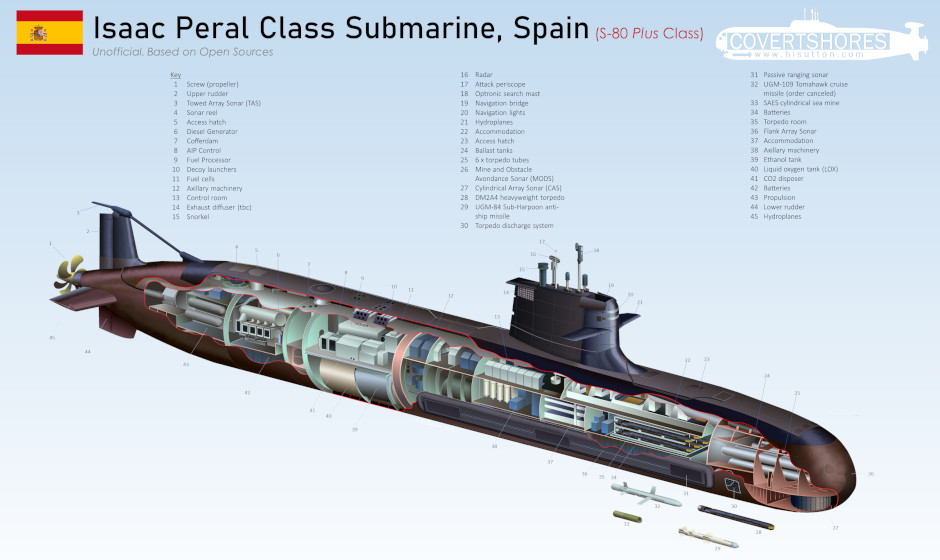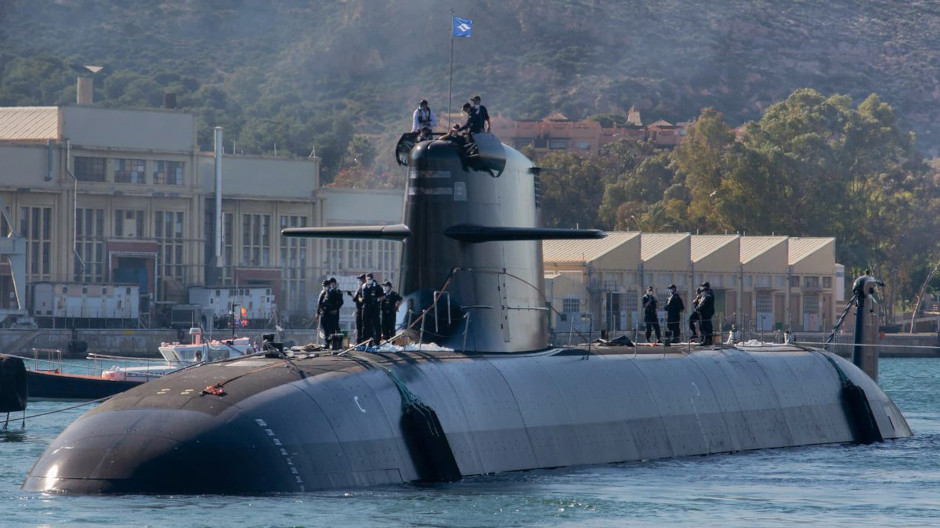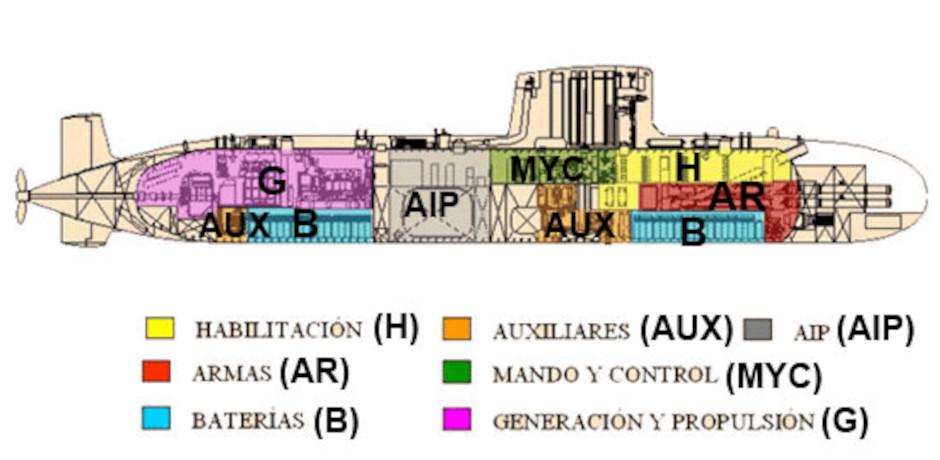Spain's S-80P Isaac Peral Class AIP Submarine
 The S-81 Isaac Peral is one of the largest non-nuclear submarines in the world. The long-range 2,965 ton boat will bring new capabilities to the Spanish Navy and is being offered on the export market. Uniquely for a Western non-nuclear submarine it is equipped to launch Tomahawk missiles.
The S-81 Isaac Peral is one of the largest non-nuclear submarines in the world. The long-range 2,965 ton boat will bring new capabilities to the Spanish Navy and is being offered on the export market. Uniquely for a Western non-nuclear submarine it is equipped to launch Tomahawk missiles.
The lead boat of the Spanish Navy’s new submarine class, Isaac Peral (S-81), what christened on April 22 2021 in Cartagena, Spain. It is one of the largest non-nuclear submarines in the world and promises to be a major step up for the Spanish Navy (Armada).
The S-80 Plus design (aka S-80P) will be characterized by its use of a bioethanol fuel cell AIP (air independent power) system. Known as BEST (Bio-Ethanol Stealth Technology) by the submarine’s builder, Navantia, this offers some advantages over other AIP systems. After use the ethanol is reformed which overcomes the need to separately store hydrogen aboard. Other AIP submarines need hydrogen tanks. Additionally, the ethanol is a relatively available fuel to source.

Original Artwork. CLICK to enlarge.
The submarine will be armed with three primary weapons. These are the DM2A4 heavyweight torpedo, UGM-84 Sub-Harpoon anti-ship missile and SAES seabed mines. It was also planned to equip them with the UGM-109 Tomahawk land attack cruise missile. This would place the Spanish Navy in an elite group of submarine operators with a ‘first night’ strategic strike capability. While the Tomahawk order has passed into history, the submarine retains the capability to carry them if they are acquired in the future. This capability is unique among non-nuclear NATO submarines.
About The Name: Isaac Peral
The lead boat’s name harkens back to a time when Spanish engineers were among the first pioneers of submarine warfare. Isaac Peral (1851-1895) was a naval officer and engineer who designed the first all-electric submarine. His craft was with the Spanish Navy in 1889, more than 10 years before the US Navy and Royal Navy commissioned their first Holland Class submarines.
In his honor, the name Isaac Peral has been given to three more previous submarines of the Spanish Navy. Despite Peral’s pioneering work the Spanish postwar submarine fleet has partly been built from acquired types. Local production of French designs started at Cartagena in the late 1960s with the Daphné-class. Four of these were build, followed by four Agosta Class boats in the 1980s.

In the 1990s Navantia (Spain) and DCNS (Now Naval Group, France) started the joint development of the Scorpène Class submarine. This was aimed at the export market and has been successful with sail to Chile, Malaysia, India and Brazil.
However the design was too small for Spanish requirements and the S-80 submarine program was launched. At this point Navantia and Naval Group parted ways and the S-80 is seen as a Spanish design. Naturally there are some general characteristics of the Scorpène in the design. This is most visible in the sail where the resemblance is clear.
An Embarrassing Problem, Now Solved
The S-80 design had a troubled gestation. Originally it was to be somewhat smaller than it is today. However, errors in calculations during design resulted in it being about 70 tons overweight. This was a serious issue and the redesign resulted in a substantially larger, but safer, design.
The popular telling of the tale is that the error resulted from a mix up between engineers "putting a decimal point in the wrong place". This is probably not true (I have been assured that it isn't!) but it makes for a good story.

The original S-80 design was noticeably shorter than the S-80P
Specifications
Displacement 2,695t surfaced, 2,965t submerged
Length 81m
Beam overall 11.6m
Draught 6.3m
Hull Diameter 7.30m
Endurance 50 days
Crew 32 crew, plus 8 special forces
Compared to the Scorpène Class
Compared to the Scorpène the S-80 has a wider hull. The pressure hull diameter is 7.3 meters (24 ft) compared to 6.2 meters (20 ft). This seemingly small difference is enough to allow for an extra deck level. It also means that the same number of torpedoes can be carried but with the torpedo room not taking up the entire height of the forward part of the submarine. Length is also greater at 80.8 meters (232 ft) compared to 61.7 meters (202 ft).
Another major difference is that the S-80 has been designed from the start as an AIP submarine. Currently no Scorpène class boats have AIP although there are plans for them to catch up. French submarine builder Naval Group, who now market the Scorpène exclusively, offer a system. And in India a local AIP system will be retrofitted to the Kalvari Class variant.

The development of the S-80 has not been without complications and delays. The first two boats, Issac Peral (S-81) and Narciso Monturiol (S-82) will enter service without the AI. Instead it will be added during a later overhaul. The third hull, Cosme García (S-83), should have the AIP installed this year. The last boat, Mateo García de los Reyes (S-84) will also receive it during construction.
The new class promises to bring the Spanish Navy’s submarine fleet thoroughly up to date. The AIP has endurance of about 3 weeks and can be operated throughout the entire depth-range of the submarine. Combined with the low crewing requirements, just 32 people, this may make it attractive on the international market.
Related articles (Full index of popular Covert Shores articles)

 Kalvari Class (Scorpene) Submarine w/Cutaway
Kalvari Class (Scorpene) Submarine w/Cutaway


 Type-212 AIP submarine w/Cutaway
Type-212 AIP submarine w/Cutaway

 Suffren (Barracuda) Class Attack Submarine w/Cutaway
Suffren (Barracuda) Class Attack Submarine w/Cutaway

 Chinese Navy's Advanced Submarine Type-039C Yuan Class. w/Cutaway
Chinese Navy's Advanced Submarine Type-039C Yuan Class. w/Cutaway


